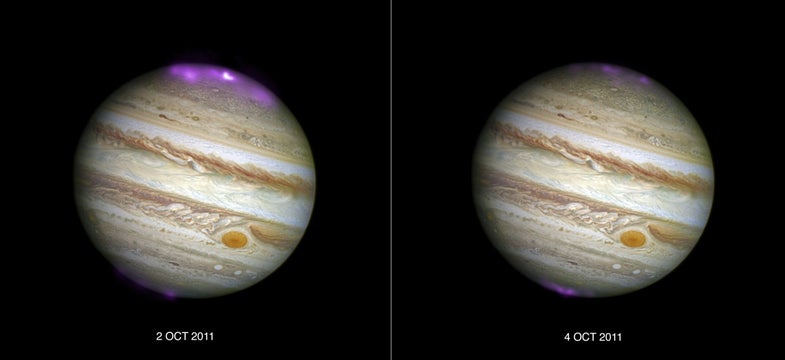Solar Storms Cause Huge Auroras On Jupiter
Northern lights

The northern lights here on Earth might seem otherworldly, but the ones on Jupiter are truly out of this world.
In a study published in Journal of Geophysical Research – Space Physics, researchers announce that they have observed the effects of a solar storm on Jupiter’s aurora, the planet’s version of our northern lights. It’s the first time the interaction between Jupiter’s aurora and a solar storm, also known a a coronal mass ejection or CME, has been observed.
Auroras occur when charged particles interact with a planet’s magnetic field. On Earth, the aurora, caused by particles from the solar wind interacting with the atmosphere, occurs in visible light (the greens and reds seen in the Northern lights), but on Jupiter, much of the aurora is in the form of x-rays, visible to instruments, but not human eyes. The image above is a composite image, showing a photo of the planet overlaid with the x-ray aurora in purple and white.
In the new study, researchers observed a strong increase in power in the aurora when particles from a large solar storm reached Jupiter in 2011. During the storm, the aurora was eight times brighter than normal, and featured an x-ray hotspot (the white dot) that pulsed much more frequently than usual. After the storm passed, the aurora went back to normal. Researchers are still looking into the data for more information, which could help give us a deeper understanding of auroras here on Earth, as well as on planets well outside our solar system.
“We want to understand this interaction and what effect it has on the planet,” William Dunn said. “By studying how the aurora changes, we can discover more about the region of space controlled by Jupiter’s magnetic field, and if or how this is influenced by the Sun. Understanding this relationship is important for the countless magnetic objects across the galaxy, including exoplanets, brown dwarfs and neutron stars.”
This isn’t the first time researchers have studied Jupiter’s aurora. Researchers have captured images of Jupiter’s aurora since the Voyager spacecraft took pictures of the planet in 1979, but are now getting an even better sense of what drives aurora’s on the solar system’s largest planet.
Jupiter has the largest aurora in the solar system, hundreds of times more powerful than Earth’s, but other planets have auroras too. The northern lights on Mars are probably blue, and researchers have even found evidence of auroras on objects outside our solar system.